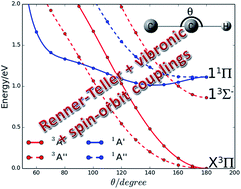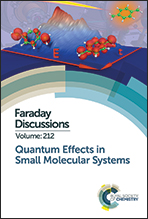Disentangling the complex spectrum of the ethynyl cation
Abstract
The ethynyl cation, C2H+, is of great importance in astrophysical media and in combustion. It is involved in the formation of larger organic compounds and in their decomposition mechanisms. Here, we investigate the low-lying electronic states of this cation using pure ab initio methodologies. The evolution of its potential energy surfaces along the stretching and bending coordinates reveals a high density of electronic states that favours mutual interactions and the mixing of wavefunctions. The ground state is of 3Π space symmetry and the lowest singlet state (1Π) is found to be a quasi-linear–quasi-linear Renner–Teller system. Our work suggests that the (spin-)rovibronic spectrum of such a molecular system is complicated, because of the contributions of multiple couplings, including Renner–Teller, vibronic and spin–orbit. We also deduced the adiabatic ionization energy of the ethynyl radical, in good agreement with recent measurements. In summary, our work shows that the ethynyl cation, in spite of its small size, still represents a challenging molecular problem to be solved.

- This article is part of the themed collection: Quantum effects in small molecular systems


 Please wait while we load your content...
Please wait while we load your content...